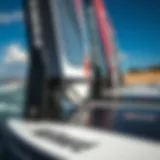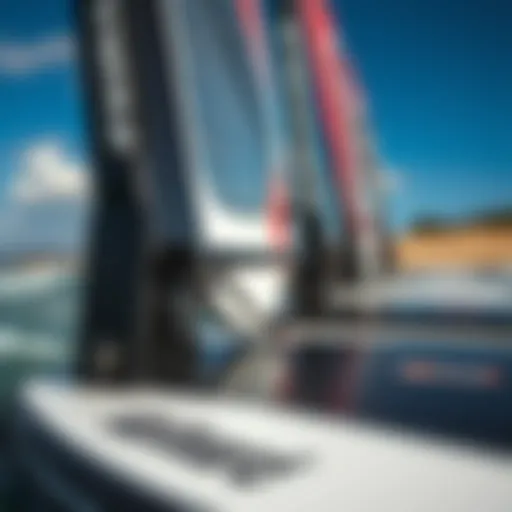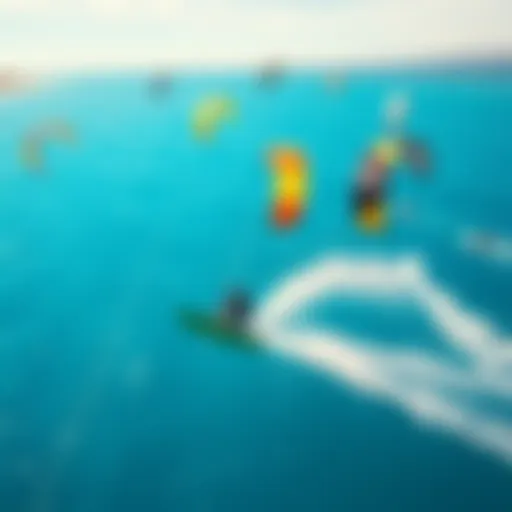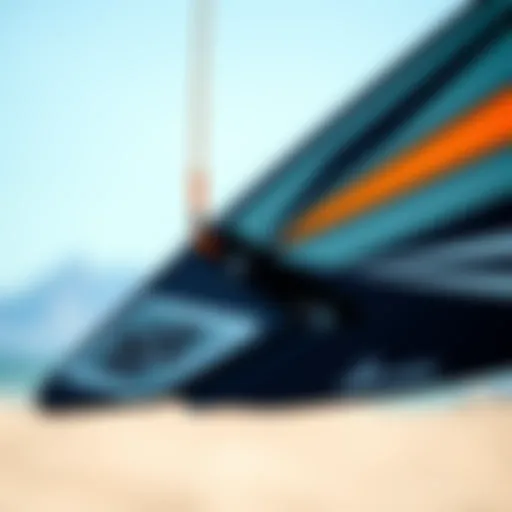Exploring Hydro Foiling Boards in Kiteboarding
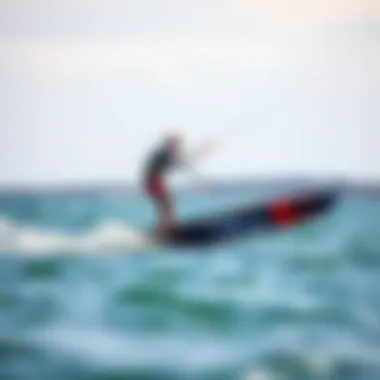

Intro
The world of kiteboarding has seen some radical changes over the years, and one of the most exciting developments is the rise of hydro foiling boards. These innovative boards elevate riders above the water's surface, enabling an experience that feels like flying. With each swell of the ocean, hydro foiling provides an exhilarating combination of speed and agility, making it a captivating addition to the sport.
In this exploration, not only will we dive into the mechanics of hydro foiling, but we will also sift through key aspects such as gear requirements, techniques that separate novice riders from the experienced, and the future trajectory of this thrilling discipline. By the end, you’ll find yourself better equipped, both in knowledge and practice, to embrace the next wave of kiteboarding.
Foreword to Hydro Foiling
Hydro foiling is not just another passing trend in the world of water sports; it marks a significant shift in how riders interact with the water. This introduction lays the groundwork for understanding the technical marvel that is hydro foiling and its profound implications for kiteboarding enthusiasts and thrill-seekers alike.
The essence of hydro foiling lies in its ability to lift riders above the water's surface via specially designed boards and foils, creating an experience that feels almost ethereal. For those involved in kiteboarding, this transformation unlocks a new realm, enhancing their ability to glide with minimal resistance and enjoy an exhilarating sense of freedom. It’s this spirit of innovation that drives riders to explore the exhilarating dynamics of hydro foiling.
Understanding Hydro Foiling
At its core, hydro foiling involves a board equipped with a hydrofoil—a protrusion beneath the board that resembles a wing. As the rider gains speed, the hydrofoil generates lift, allowing the board to rise above the water’s surface. This elevation reduces the drag significantly compared to traditional boards, resulting in smoother and faster rides.
Riders experience newfound agility when gliding above waves, making maneuvers not only easier but also more thrilling. The sensation often described is akin to flying over the water, a feeling that resonates deeply with those who have spent years navigating the waves.
Historical Context
The evolution of hydro foiling is rooted in a rich history of water sports innovation. While the concept of lifting a vessel above the water isn't new—think of early hydrofoil boats—its application in kiteboarding is relatively recent. The first instances of hydro foiling in kiteboarding can be traced back to the early 2000s, where a small group of pioneers began experimenting with various designs. Over the years, advancements in materials and engineering refined these designs, making them more accessible to a broader audience.
This growing interest has sparked a wave of innovations, pushing boundaries and inspiring competitors to explore new terrains and techniques. Events such as the Hydrofoil Kiteboard World Cup have solidified the sport's legitimacy, bringing together riders from different backgrounds and cultures to celebrate their shared passion.
As we delve deeper into the various facets of hydro foiling, from its mechanics to performance advantages and beyond, one cannot overlook how this fascinating evolution is shaping the future of water sports. Exploring these dimensions not only enhances the rider's experience but also cultivates a unique community that thrives on adventure and innovation.
The Mechanics of Hydro Foil Design
Understanding the mechanics behind hydro foil boards is essential, as this knowledge directly influences performance and rider experience. The design elements play a pivotal role in shaping the overall functionality of these boards. From the materials used to the shape and size of components, each aspect contributes to how effectively the board operates on the water. Hydro foils essentially enable riders to glide above the surface, significantly reducing drag and increasing speed, which is a game changer in the world of kiteboarding.
Components of a Hydro Foil Board
A hydro foil board is engineered from several key components, each serving a specific purpose. The primary parts include the board itself, the mast, and the foil.
- Board: The base for the rider, it’s usually designed to be lightweight yet sturdy, allowing for maneuverability.
- Mast: This is the vertical support that connects the board to the foil. The height of the mast influences how high the rider can fly above the water.
- Foil: Comprised of the front wing, rear wing, and fuselage, the foil is crucial for lift generation and drag reduction. The design and angle of the wings affect the performance capabilities.
These components work in tandem to provide an optimal hydro foiling experience. The layout can be adjusted to suit the rider’s skill level and style, making customization an exciting aspect of hydro foiling.
Hydrodynamics at Play
Lift generation
Lift generation is a core principle that allows hydro foils to function as intended. It relates to how the foil is shaped and positioned in the water. A properly designed foil creates differences in pressure between its upper and lower surfaces. This pressure differential generates lift, which allows the board to rise above the water's surface.
A well-designed foil can produce lift even at lower speeds, making it appealing to both beginners and experts. The unique feature of lift generation is its efficiency; once a rider is on the foil, they experience reduced resistance from water, leading to a smoother ride.
The benefits of effective lift generation include:
- Enhanced Speed: With lift, less energy is required to maintain speed, enabling longer rides with fewer exertion.
- Improved Maneuverability: Riders can make sharper turns and perform tricks with ease, thanks to the board's unique ability to glide above the water.
However, not all lift is created equal. An improperly sized foil can lead to excessive lift, making it challenging for less experienced riders to control and increasing the risk of falls.
Drag reduction
Drag reduction is another crucial aspect of hydro foiling and complements lift generation. When a rider is foiling, the major forces acting upon the board are lift and drag. The design of the foil must minimize drag while maximizing lift to achieve efficient movement.
One of the key characteristics of drag reduction involves the shape and angle of the wings. A streamlined design allows the foil to cut through water with minimal resistance. This is why materials such as carbon fiber are often used to construct high-performance hydro foils, as they provide both durability and aerodynamic efficiency.
The unique feature of drag reduction is its role in conserving energy, allowing riders to cover more distance without exerting excessive effort. The advantages of reduced drag include:
- Longer Distance Travel: Increased efficiency means less fatigue for the rider.
- Greater Control at High Speeds: A design that effectively minimizes drag can instill greater confidence in riders as they reach faster speeds.
While the benefits are significant, some downsides may arise from extreme drag reduction techniques. Overly aggressive designs can create instability, especially in choppy water conditions, leading to a challenging riding experience.
"Hydro foiling transforms the way we interact with water. Understanding its mechanics isn't just for experts; it's a journey every rider should embark on."


By diving into the mechanics of hydro foil design, riders can make informed choices that enhance their experience, whether they are just starting out or looking to elevate their skills. The interplay of lift and drag highlights the delicate balance required to master this exhilarating sport.
Performance Advantages
Understanding the performance advantages of hydro foiling boards is crucial for anyone venturing into the world of kiteboarding. These unique boards transform the riding experience, offering several benefits that can enhance both the performance and enjoyment of the sport, making them especially appealing for riders of all levels. From seasoned experts looking for extra speed to beginners trying to find their footing, hydro foils cater to a variety of needs.
Speed and Agility
One of the standout features of hydro foiling boards is their ability to deliver impressive speed. When a foil board lifts out of the water, it reduces drag significantly. This means that riders can reach higher speeds with less effort than they would with traditional boards. The sensation of flying above the water is exhilarating and liberating. Riders often talk about the sheer joy of cruising at speeds that seem impossible, especially when powered by just wind or a small kite.
The agility of hydro foiling boards can't be understated either. Their design allows for sharper turning and maneuvering, making it easier for riders to navigate through waves or tight spots. With a well-tuned board, a rider can execute quick transitions and spontaneous tricks that would be difficult on a standard kiteboard. Additionally, the lift created by the foil allows for smoother landings after jumps, a feature that appeals to those looking to perfect their aerial moves.
"The moment I felt the lift and caught some speed, I knew I was hooked. It’s like carving through butter. I could change directions with just a tilt of my hips."
Stability in Diverse Conditions
Hydro foiling boards shine not only in performance but also in stability across various water conditions. Unlike regular boards that can bounce and jolt through choppy waters, foiling provides a smoother ride. Once on the foil, the board glides over the surface, minimizing the impact of waves. This increased stability allows riders to navigate more challenging environments confidently, from rough ocean swells to the calmest flat waters.
Further enhancing this stability is the ability of foils to maintain lift and control. Even in gusty winds, riders find that they can remain more composed than on traditional setups. The board can handle sudden changes in wind speed or direction, enabling riders to maintain balance. This aspect is particularly beneficial for those who are just starting; they can progressively build confidence without the anxiety of being tossed around by the elements.
In summary, the performance advantages of hydro foiling boards encompass remarkable speed, agility, and stability. These elements combine to create an enjoyable and dynamic riding experience. Whether you're chasing the thrill of speed or seeking a reliable board for unpredictable conditions, hydro foiling offers distinct benefits worth exploring.
Choosing the Right Hydro Foil Board
Choosing the right hydro foil board is a crucial part of maximizing one's experience in the sport. A well-chosen board not only enhances performance but also significantly boosts the overall enjoyment of riding on water. Understanding various factors like skill level, riding style, and board size can help both beginners and seasoned riders make informed decisions. This article aims to shed light on these elements, offering guidance for anyone interested in finding their perfect match.
Factors to Consider
Skill level
Skill level plays an important role when selecting a hydro foil board. Beginners often benefit from boards designed for stability and ease of use. These boards create a forgiving environment that allows novices to focus on learning the basics without the constant worry of losing balance. On the flip side, advanced riders might seek boards that offer more responsiveness and maneuverability, enabling them to perform tricks and complex movements with greater ease.
- Key Characteristic: Beginner boards tend to be wider and feature higher lift, making take-offs easier. Advantage: Great for those still finding their footing in hydro foiling.
- Disadvantage: May lack the performance expected by those with experience, potentially limiting tricks or advanced riding styles.
Riding style
One's riding style is equally critical in the board selection process. Riders who enjoy cruising on flat water will look for boards optimized for efficiency and speed. In contrast, those who tackle choppy water or waves may prefer a board that offers better control and stability during unpredictable shifts.
- Key Characteristic: A board tailored for cruising will feature a streamlined design to minimize drag. Advantage: Ideal for long-distance rides or relaxed sessions.
- Disadvantage: Might not perform well in rough conditions, which could frustrate more adventurous riders.
Board size
Board size directly influences the overall hydro foiling experience. A larger board might provide increased stability, especially beneficial for novices or those learning to navigate various conditions. Conversely, smaller boards can facilitate sharper turns and tricks, making them a top pick for skilled riders looking to enhance their maneuvers.
- Key Characteristic: Bigger boards generally support more weight and offer a larger surface area for lift. Advantage: Instills confidence in beginners, allowing them to find their balance.
- Disadvantage: May feel cumbersome or sluggish for advanced riders, who would benefit more from a lighter, smaller model.
Recommended Brands and Models
When it comes to the market, several brands have established themselves as leaders in hydro foiling technology. Popular names include:
- Slingshot: Recognized for their well-rounded boards that suit a wide spectrum of riders, from beginners to pros.
- Naish: Known for high-performance models with exceptional stability in turbulent waters.
- F-One: Offers innovative designs and high-quality materials, often catering to those looking to push their limits in riding.
For those who want to explore specific models, consider checking out the Hydro Foil World for community reviews and suggestions. Buyers can often glean insights from user experiences on platforms like Reddit's hydrofoiling forums or directly from manufacturer websites, which can help narrow down choices.
Choosing the right hydro foil board is not just about personal preference; it's about enhancing your skills and enjoying every session on the water. Knowing which factors to prioritize ensures that riders find a board that truly fits their needs.
Safety Considerations
Safety is a paramount concern for anyone venturing into the world of hydro foiling. As thrilling as it can be to glide above the water, understanding the inherent risks and mitigating them is essential for a rewarding experience. In this section, we’ll discuss crucial elements that underscore safety while hydro foiling and the substantial benefits proper safety precautions provide.
Consider this: without attention to safety, what should be a fun adventure can quickly turn hazardous. Knowing how to protect oneself while enjoying hydro foiling not only enhances one's confidence but also supports better riding techniques. This leads to improved performance and an overall positive impact on the sport.
Essential Safety Gear
Selecting the right safety gear is akin to arming oneself for battle against the unpredictable nature of water sports. Here’s a breakdown of the fundamental equipment one should consider:


- Helmet: Protecting your noggin is non-negotiable. A good helmet can prevent serious injuries from falls or collisions.
- Impact Vest: This offers additional flotation and protection for your torso, which can be crucial if you take a tumble.
- Wetsuit: Depending on the water temperature, a wetsuit keeps you warm and protects against abrasions, should you wind up in the drink unexpectedly.
- Footstraps and Pads: Ensuring your stance is secure can help prevent losing balance and falling off the board.
- Leash: A leash keeps your board close if you crash, preventing it from becoming a runaway hazard.
- Personal Flotation Device (PFD): Especially for beginners or in open water, a PFD provides an essential safety buffer.
Having the right gear on your side can make all the difference in keeping injuries at bay while enjoying the thrilling experience of hydro foiling.
Common Risks and Prevention
Even the most experienced riders are not immune to risks while out on the water. Understanding these risks is only half the battle; effective prevention strategies will make for a safer and more enjoyable experience.
- Collisions: Hydro foiling involves maneuvering at high speeds. Riders should always be aware of their surroundings, including other riders and boats. To minimize collision risks, maintain a safe distance from others and have clear communication signals.
- Falls: Falling is part and parcel of learning. However, avoiding risky maneuvers before mastering the basics will diminish fall frequency. It’s wise to practice in calm conditions to better learn how to handle the board at lower speeds.
- Weather Changes: Sudden wind shifts or changes in water conditions can be dangerous. Always stay updated on weather forecasts and be prepared to exit the water when conditions become unfavorable.
- Overexertion: Listen to your body and don't push beyond limits. Fatigue can contribute to accidents; take breaks when needed to maintain focus and energy.
- Cold Water Shock: Entering frigid waters can lead to shock. Wearing a wetsuit not only insulates but like it acts as a first line of defense against hypothermia.
"Safety is not a gadget but a state of mind."
In summary, understanding and implementing safety measures while hydro foiling can vastly improve one's overall experience. Protective gear, awareness of risks, and smart practices are foundational elements that every rider must consider. The ultimate goal is to blend the thrill of hydro foiling with enough safety precautions to keep the experience joyful and memorable.
Skill Development Strategies
When it comes to hydro foiling, skill development is everything. It is not just about hopping on a board and gliding across the water. Whether you’re a newbie starting this thrilling journey or a seasoned rider aiming to improve, understanding various skill development strategies can enhance your experience. Developing these skills not only helps in mastering the art of hydro foiling but also ensures safety and confidence on the water.
Fundamentals for Beginners
Starting out in hydro foiling can be a mixed bag of excitement and challenges. Here are some key fundamentals that every beginner should embrace:
- Understanding Balance: The first step is getting a feel for the board. Leaning slightly forward helps in lifting the hydrofoil out of the water. It might feel wobbly at first, but maintaining a centered stance is crucial.
- Body Positioning: Sit low, keep your knees bent, and flex your ankles. This low stance allows for better control. Picture a spring—this flexibility can absorb shocks caused by waves or gusts of wind.
- Mastering the Takeoff: Start in shallower waters with minimal waves. Begin by pushing against the water with your paddle while standing up. As you gather speed, focus on your balance.
"Practice makes perfect; balance is key!"
- Learning to Fall: Yes, falling is part of the process. Understanding how to safely fall can prevent injuries. A forward or sideways fall reduces the risk of impact injuries. Always keep your arms closer to your body when you tumble.
- Utilizing Lesson Resources: Leveraging local instructors or online communities, like www.reddit.com/r/foiling, can provide insights and tips tailored to your region. Connecting with enthusiasts can also be motivating.
Advancing Techniques for Experienced Riders
Once you’ve got the basic skills down, it’s time to take it to the next level. Experienced riders should focus on refining techniques and adding some flair:
- Edge Control: Learning to manipulate the edge of the board can open up a whole new world of tricks. By shifting weight on heels and toes, riders can maintain control even at high speeds.
- Carving: Transitioning from straight lines to carving allows for sharp turns and improved maneuvers. Start slow and gradually increase speed while making turns.
- Jumping: To get air under your foil, you need to time your takeoff perfectly. Use the energy from small waves or chop to spring upwards. This will require practice to nail the timing and landing technique.
- Reading Water Conditions: Understanding how to read water conditions can affect your performance drastically. This translates to navigating waves, currents, and wind direction efficiently.
- Strength and Conditioning: Off-water training focusing on core strength, balance, and flexibility can improve performance. Consider yoga or resistance training to complement your time on the water.
Engaging with other riders, attending workshops, or competitions can provide practical experience. Checking out organizations like the Kiteboarding Association to stay updated on advancements can be beneficial.
Keeping these strategies in mind while practicing will not only bolster your skill set but also deepen your enthusiasm for hydro foiling. As you progress, remember that the journey is continuous; there’s always a new technique or trick just waiting to be tried.
Hydro Foiling in Different Environments
Hydro foiling opens up a plethora of riding possibilities that are distinctly influenced by the environment. Understanding how hydro foiling interacts with different water settings is crucial for optimizing performance and safety. Riding styles and board designs can be greatly impacted by the environment, which in turn affects the enjoyment of the experience.
Ocean versus Flat Water
Hydro foiling in the ocean presents riders with unique challenges and thrills that aren’t found in flat water conditions. Ocean conditions, often characterized by waves and currents, can demand a higher level of skill.
- Wave Riding: When you're out in the ocean, the waves can become your playground. Lift created by waves can enhance performance but requires finesse to maintain balance.
- Currents and Tides: The ever-changing tidal movements can affect how the board behaves in the water. Riders will need to recalibrate their skills according to the current’s strength and direction.
- Immersive Experience: Riding amid the ocean's vastness can create a sense of freedom and connection with nature, enhancing the overall experience.
In contrast, flat water environments offer stability and consistency. Here’s what to consider:
- Easier Learning Curve: Flat water allows beginners to focus on mastering balance and control without the added complexity of waves.
- Speed and Performance: Riders may achieve higher speeds on smooth surfaces, facilitating tricks that rely on consistent lift.
- Safety: Flat water often presents fewer hazards associated with waves, making it a safer space for experimental maneuvers.
"Choosing the right environment can make the difference between an exhilarating session and a frustrating one."
Ultimately, the choice between ocean and flat water hydro foiling depends on one’s skill level and what the rider hopes to achieve.
Wind Conditions and Their Impact
Wind conditions are another critical aspect of hydro foiling that can dramatically change the experience. Here are some factors to ponder:
- Wind Strength: Strong winds can help riders achieve greater lift quicker, whereas light winds might necessitate longer sessions to catch sufficient air.
- Wind Direction: Crosswind situations can create handling challenges. Understanding how to maneuver in these conditions can elevate one’s performance.
- Consistency: When the wind blows steadily, riders can establish a more predictable routine, enhancing the chances for precision in performing tricks.
- Gusts and Lulls: Varying wind patterns can create situations where lift can disappear suddenly. Recognizing these patterns and adapting riding techniques is crucial.
Deciphering wind conditions not only enhances performance but also fosters safety, allowing riders to prepare adequately for the challenges the weather might bring. In a nutshell, the environment in which one chooses to foil significantly impacts both the enjoyment and the skill development associated with the sport.
Community and Culture around Hydro Foiling


The culture surrounding hydro foiling is as integral to the experience as the boards themselves. This community is more than just a circle of enthusiasts; it is a vibrant tapestry woven from shared experiences, mutual support, and collective learning. Riders come together, sharing not only their passion for the sport but also their journeys, struggles, and successes. In this section, we explore how connecting with other riders and engaging in events and competitions can tremendously enhance the hydro foiling experience.
Connecting with Other Riders
In the hydro foiling community, camaraderie reigns supreme. Connecting with other riders happens in various forms, from local meet-ups at popping spots to online forums buzzing with advice. For many, friendship stems from a mutual love of slicing through waves and taking to the skies. No matter where you're from, the sense of belonging is palpable.
Riders often share tips about gear, techniques, and best practices. These interactions serve as invaluable opportunities to learn, grow, and ultimately enhance one's riding skills. It’s not just about pumping a foil board; it’s about exchanging ideas and fostering camaraderie. Social media platforms like Facebook and Instagram host dedicated groups and pages where riders post their achievements, ask for advice, or arrange meet-ups. Subreddits on platforms like Reddit offer an abundance of information ranging from beginner guides to the latest tech discussions.
Local riding clubs can serve as a nurturing ground for new riders. Here, experienced foil enthusiasts often share their knowledge in person, hosting clinics or informal gatherings. It's all about creating an environment where everyone, from rookies to pros, can find their footing—and maybe even a little flight.
Events and Competitions
Events and competitions play a crucial role in strengthening the community around hydro foiling. They foster a healthy sense of competition and encourage riders to push their boundaries. Many avid riders look forward to local and national competitions as a highlight of their riding calendar. These events not only serve as a showcase for the latest and greatest in hydro foiling but also create an opportunity for networking and friendship.
Competitions range from casual race days to more serious championship events. Riders can often find themselves in the midst of exhilarating races or breathtaking freestyle competitions, where they witness the remarkable skills of others while also challenging themselves to improve.
Participating in these events does more than just build skills; they allow riders to meet manufacturers and industry reps, gaining insights into product development and future innovations in the sport. The thrill of competition acts as a catalyst, motivating riders to refine their techniques and aim for personal bests.
Importantly, these gatherings often instill a sense of appreciation for the sport and its environment. Many events incorporate clean-up initiatives, where participants work together for better natural preservation, reflecting a collective responsibility towards maintaining the ecosystems we enjoy.
"The joy of hydro foiling is not just in mastering the board, but in sharing the ride with others. A community is built on the waves we surf together."
In summary, the culture and community of hydro foiling create a compelling, enriching experience that goes beyond the individual. Finding friends through common interests and participating in events enables riders to fully immerse themselves in the sport while uplifting one another in the process. This sense of community not only enhances one's skills but also builds lasting connections that extend beyond the water.
The Future of Hydro Foiling Technology
As we glance towards the horizon, the evolution of hydro foiling technology emerges as a focal point for enthusiasts and manufacturers alike. Understanding where this technology is heading is crucial for kiteboarders, outdoor enthusiasts, and gear manufacturers. The rapid advancements in materials and design have the potential to reshape the landscape of the sport, enhancing performance and accessibility.
Innovations on the Horizon
The future of hydro foiling is bright with innovation, as breakthroughs in design and materials promise to push the boundaries of speed and maneuverability. Here are some notable advancements:
- Lightweight Materials: The shift towards lighter and stronger composite materials, such as carbon fiber and advanced plastics, enables boards to be more agile while maintaining strength. These innovations provide both recreational and competitive riders with a significant edge.
- Smart Technology: Imagine a board equipped with sensors that relay real-time performance data back to the rider. Augmented reality overlays, integrated into goggles or helmets, could provide critical insights on speed, stability, and even wave timing. This technology speaks to both novice riders eager to learn and seasoned professionals refining their techniques.
- Modular Designs: Future hydro foils might embrace modular designs, allowing riders to customize their set-up according to conditions and personal preferences. This flexibility caters to both necessary practicality and personal expression, which is increasingly important in adventure sports.
As these innovations come to fruition, they promise to demystify hydro foiling for a wider audience, promoting widespread adoption in the kiteboarding community.
Sustainability and Environmental Impact
As hydro foiling technology evolves, it's imperative to consider its environmental impact. The question is not just about improving performance but ensuring that the methods utilized align with sustainable practices.
- Eco-Friendly Materials: A shift toward eco-friendly materials in production is already in motion. Processes that utilize recycled plastics and bio-based composites minimize waste and reduce the carbon footprint associated with manufacturing.
- Energy Efficiency: Innovations in hydrofoiling designs aim to enhance efficiency, meaning less drag in the water leads to lower energy usage. Less energy exerted results in longer sessions without the wear and tear on both the rider and the equipment.
"As technology advances, the focus must remain on not just how fast we can go, but also how responsibly we can do so."
- Community Awareness: Brands are now encouraged to engage with the community on initiatives focused on ocean preservation. By aligning with organizations dedicated to marine conservation, the hydro foiling community can craft a narrative that emphasizes conscious participation in water sports.
The future of hydro foiling is not solely about cutting-edge technology; it's about creating a sustainable path forward. As both riders and manufacturers embrace these changes, the sport can flourish responsibly and enjoyably.
For further reading on hydro foiling technology and its impact, you can explore resources at Wikipedia and Britannica.
Follow community discussions on platforms like Reddit and connect with fellow enthusiasts on Facebook.
The landscape is ever-changing, and by staying informed, riders can ensure they’re riding on the crest of the wave—both literally and metaphorically.
Ending
The exploration of hydro foiling boards has enough depth to fill multiple books, yet we wrap it up here with significant takeaways that are both enlightening and practical. When it comes to riding on a hydro foil, the implications extend beyond personal enjoyment; they include technical proficiency, awareness of environmental factors, and community connection. This article detailed various facets of hydro foiling, from the mechanics of board design to the culture cultivated around the sport. The balance between thrill-seeking and safety remains paramount—understanding gear and local conditions ensures enjoyable experiences.
Recap of Key Insights
- Design Mechanics: Grasping how hydro foils work—lift generation, drag reduction—enables riders to choose suitable equipment for their needs. It's not just about speed; it's about control.
- Performance Benefits: Hydro foiling demonstrates superior stability and agility compared to traditional boards, which can drastically enhance your overall riding experience.
- Safety First: Essential safety gear like helmets and impact vests should never be overlooked. Knowledge of prevalent risks in different environments is crucial for all riders.
- Skill Development: Mastering basic maneuvers before progressing to advanced techniques can create a smoother learning curve. Each rider's path is unique—and that's what makes the community so vibrant.
- Future Outlook: The progression of hydro foiling technology may witness eco-friendly innovations aimed at reducing environmental impact, ensuring the sport is sustainable for future generations.
Encouragement for Continued Exploration
As with any passion, the joy of hydro foiling lies in the journey as much as the destination. Don't hesitate to engage in rider forums, attend workshops, and participate in local competitions. Seek inspiration from the stories of others within the community. Whether it's exchanging tricks, experiences, or gear suggestions, each conversation can open up new avenues of understanding.
Consider mixing it up—experiment with various riding conditions, styles, or even different types of foils. The beauty of hydro foiling is in its adaptability; it is a sport where your creativity can directly influence performance. Always remember to keep the thirst for knowledge alive—there's no end to what you can learn and achieve.
Embrace the elements, push your limits, and enjoy every moment spent on the water. The pursuit of mastery in hydro foiling is both an individual adventure and a shared experience. So gear up, hit the waters, and let the wind guide you toward new horizons!
Hydro foiling is more than just a sport; it’s a way to connect with nature and fellow enthusiasts, igniting a profound sense of freedom.
For further insights and a wider perspective on hydro foiling, check out resources such as Wikipedia, Britannica, and spirited discussions on Reddit.


